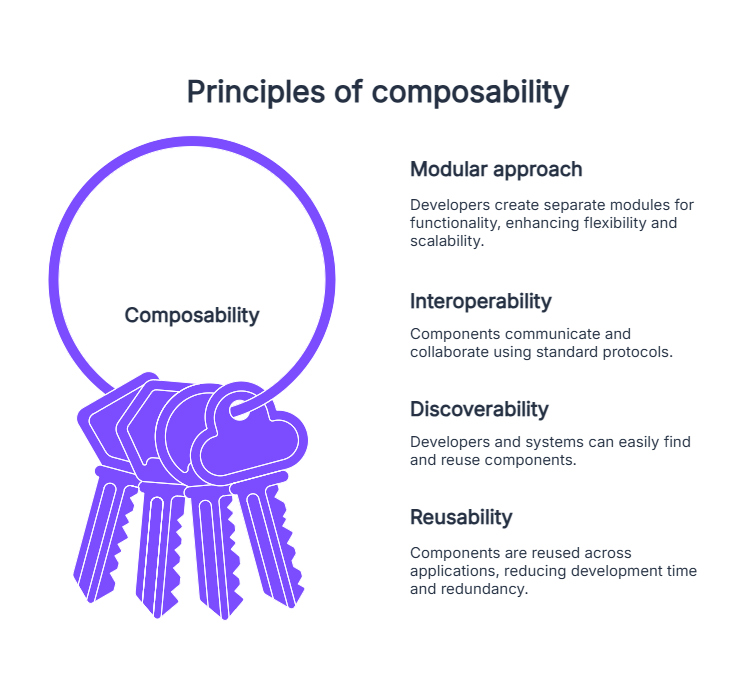What is composability and why it matters in tech today

Share

The future of software development is composable. Did you know that composability enhances agility, reduces costs and nurtures business innovation? To leverage the benefits of composable, switch to Contentstack today.
Highlights
You’ll learn about why you need a composable architecture:
- Future-proofs your tech stack: Composability ensures your systems are flexible, agile and cost-efficient
- Enhances collaboration: Create a knowledge-sharing culture with modular, reusable components
Uses cloud-native technologies: Content models and microservices make your business scalable and adaptable
- Ensures continuous improvement: Track your systems for ongoing optimization
Have you tried putting together a do-it-yourself kit from Amazon? Or have you tried assembling furniture based on the instructions? Do you create a mess of parts that do not seem connected?
You would have witnessed this mess at one point or another. But what would happen if the same DIY kit were made using composability in mind?
All the pieces fit together, helping you assemble your kit without facing any issues.
For this reason, composability is necessary to future-proof your tech stack. When adopting a composable architecture:
- You can interchange software components without overhauling the entire system
- You’re no longer locked with a single vendor
- You develop agile and flexible systems
- Your systems are scalable
But first things first, what is the definition of composable?
What is composability in software development?
Composability is a design approach that improves application development. It reuses and assembles existing components depending on your business and users' unique needs, making your system more adaptable, agile and reliable.
The concept of composable infrastructure is like Lego blocks. Each piece or component serves a definite purpose. You can assemble and reassemble these various building blocks as and when required. This helps you break larger software components into smaller, modular and reusable components.
You can assemble these components to create new systems without building from scratch. This accelerates your software development process and reuses your existing assets.
To sum up: Composability makes your systems scalable, flexible and reliable while ensuring tailored user experiences across multiple platforms.
Start your free trial with Contentstack today. Transform your brand's digital presence with Contentstack's open MACH architecture and industry-leading technology. Witness a significant reduction in publishing and development time, and elevate your content management. Start your free trial now.
Principles of composability
Modular approach
Developers can use a modular approach to create separate modules of functionality and combine them to create more sophisticated features. The same principle applies to a login module. It manages authentication independently, allowing developers to work on it separately without affecting the rest of the application.

Interoperable
To achieve true composability, individual components need to communicate and collaborate. You can use standard protocols like application programming interfaces (APIs) and data formats to integrate components from various sources.
Discoverable
An important element of a truly modular system is the ability to reuse individual components to deliver new user experiences. For this to happen, developers and systems must discover all components.
Reusable
A core goal is to increase the reuse of existing components across different applications and systems. Reusing components reduces development times, minimizes redundancy and promotes consistency across projects.
Characteristics of composable systems
Modular systems have the following characteristics:
Scalable
These systems can scale vertically and horizontally to match your business growth. With vertical scaling, you can design and add resources. Horizontal scaling incorporates instances of components that distribute the load. Your system adjusts to varying demands while maintaining optimal performance.
Agile
Knowing the latest market shifts and what your customers actually want is something that sets your business apart. That’s why you need a modular system. You can adapt quickly with it. For instance, you can roll out a new feature, change existing ones or respond to sudden changes. Instead of overhauling your entire setup, you can update just the pieces you need.
Flexible
Being flexible allows you to update, include or remove different features. Keeping up with AI allows your business to stay competitive and meet what users need. If your approach is flexible, it will be easier to meet both business and user needs.
Cloud-native design
Cloud-native systems are based on modular components. Using cloud computing, you ensure better performance and higher efficiency.
Benefits of composability in software development
Going modular offers numerous benefits, such as:
Faster speed to market
A modular architecture combines and readjusts the software components. As a result, you reduce the time to introduce new functions or products. By going composable, you quickly and efficiently react to market fluctuations and customer demands.
Increases resilience
A composable architecture ensures that your systems are more resilient and reliable. The problem with a single component doesn’t affect the entire system. You can face an issue with just one component, but it won’t affect your entire setup.
Reduces development cost
Modularity can help you save significant costs. Reusing components across multiple applications lowers the development efforts and costs. As composable systems are scalable and efficient, you reduce resource wastage, improving cost efficiency.
Nurtures digital innovation
Developers can combine and recombine components in a modular system to fulfill market needs. They can create value-added features without facing the complexities of existing systems.
Future-proofs your tech stack
Composable architectures adapt your applications to emerging technologies and market trends. With a forward-thinking aspect, your software development investments provide value in the long run.
Contentstack: Your partner in scaling digital experiences. Twice named a Leader in Forrester's composable DXP award, Contentstack offers an innovative approach to DXP. Experience our 100% microservices architecture and API coverage that allows instant scalability. Start your free trial today.
Composability and agile systems
Composability and agile methodologies are interconnected. Each modular component contributes to the success of the other. Companies that adopt agile principles are the ones with flexible software systems. They are better adept at meeting the changing market dynamics. Modular components make iterations easy, helping you make real-time adjustments and deliver value to customers. A modular approach helps you develop, test and deploy modules to make changes depending on market requirements. Due to the composable components' scalable and reusable nature, your agile teams can improve their workload management and task delegation and deliver value.
How to implement composability
Here’s how you can implement composability:
Assess your existing architecture
Analyze your current software architecture to identify which components you can modularize. Assess your existing architecture to understand the dependencies between various components. Determining the possibility of breaking software components into smaller, independent modules makes it easier to assess your requirements.
Define standards and guidelines
Defining guidelines and standards helps you promote a modular approach, making your systems reusable. By defining clear interfaces for components, you standardize data formats and set up protocols for communication between modules and services.
Develop a modular software design
Design your software architecture with modularity in mind. It helps you create self-contained components to develop, test and deploy. So, build components that address specific functionalities, allowing you to reuse them across different applications.
Create a culture of collaboration
Encourage your teams to cooperate by sharing their expertise and making the most of each other’s work. Search, share and use a wide range of tools to create collaboration in your company.
Use cloud-native technologies
Use cloud-native technologies to make your composable systems scalable, flexible and resilient. Cloud-native apps and tools simplify the management of modular components.
Track and monitor
Once implemented, track the performance and use of modular components. With these insights, you optimize other components and remain aligned with your business goals.
Educate and train teams
Provide developers and IT professionals with training on composability principles and technologies. You can easily develop modular systems when your team members are knowledgeable and proficient.
How has Contentstack’s composable architecture helped Bol.com?
Bol.com moved to Contentstack's composable architecture to eliminate its outdated CMS. They wanted a modular and modern solution to fulfill their content requirements. Contentstack's user-friendly and composable system helped developers and content creators to create and manage content.
They implemented the composable architecture in a phased manner. Bol liked the platform's ease of use, image management capabilities and content scaling. After using Contentstack, Bol improved campaign efficiency and performance, ensured higher customer experience and increased click-through rates.
This is what Lennart Billekens, IT Architect at Bol.com, said, “We just wanted to use content across the channels, and for that, headless is the way to go.”
You can read the complete case study here.
Overcoming challenges in implementing composable systems
Composable systems come with their share of challenges, and you can overcome these challenges through:
- Managing complexity: Converting to a modular architecture can make your systems more complex as it breaks monolithic systems into smaller modules. The solution is to use a single business capability, slowly expand and use domain-driven design principles.
- Overcoming resistance to change: Your team may resist changing to a modular system. With clear communication, you can reduce your team's resistance. You can engage stakeholders and development teams early on to build momentum.
- Bridging skill gaps: New skills are needed as you shift to composable infrastructure. Offering training and opportunities to upskill is possible for all your staff. Establishing a culture that supports learning all the time helps your teams adapt to changes.
FAQs
What does composability mean?
Composability is a design approach where you build systems from interchangeable, modular components.
What is composability in cloud computing?
Composability in cloud computing helps you assemble and manage infrastructure resources to meet application demands.
What are composability components?
Composability components are modular, reusable elements combined in various configurations to build complex software applications.
What is an example of composability?
An example of composability is a web application built using microservices. Each service handles a specific function, helping you develop, deploy and scale it independently.
Learn more
Composability is a business strategy that increases agility. Besides integrating new technologies, a composable architecture ensures innovation, flexibility and resilience. To discover how composability can help your business, talk to us.



